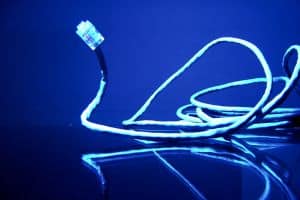News, Techie
Techie Question: If it’s a digital video signal, why does the video quality degrade when using ethernet cabling?

Just recently, I was involved in a discussion with a couple of friends about whether one of them should install network cabling throughout his new home. We started brainstorming reasons why he should do it:
1. You’re able to connect to your Local Area Network with faster and more reliable speeds than wireless
2. It will be more secure than wireless
3. Cheaper to install the cabling before the walls go up
4. You’re able to use the network cabling to extend video and sound
 Now, whilst we were talking about point 4, we ended up having a heated debate whether you degrade video quality when extending a DIGITAL video signal. One my friends raised a good question which was “If you send 0 & 1’s down the ethernet cable, you would expect those 0 & 1’s to come out the other end. So why would you loose video quality if it’s digital?” – that was a really good question and I was quite reluctant to answer because I didn’t have an answer.
Now, whilst we were talking about point 4, we ended up having a heated debate whether you degrade video quality when extending a DIGITAL video signal. One my friends raised a good question which was “If you send 0 & 1’s down the ethernet cable, you would expect those 0 & 1’s to come out the other end. So why would you loose video quality if it’s digital?” – that was a really good question and I was quite reluctant to answer because I didn’t have an answer.
So for those techies out there, how would you have responded to this question?
Feel free to respond to this question by adding a comment.
LIKE WHAT YOU'VE READ?
When you subscribe you will also join other Digital Signage readers who receive our content right in their mailbox. Good luck!






Great answers Jim and Eric.
Would I be right in assuming that rather than using CATx a better solution to extend video is Fibre? That way you can achieve a better bandwidth to carry the video?
Video-over-CATx systems I’ve used send RGB similar to a VGA cable, not data like on your computer network (hence you can’t mix them or throw in a D-Link somewhere in the middle). The good one’s will take a VGA signal and send it up to 2000ft. @ 1920×1080. The issue when you’re sending a video over long distances is that the red, green and blue signals travel at different speeds. The longer the distance, the more pronounced the lag between colors. This leads to distortions in the image like ghosting. That said, these systems include the possibility to tune them–adjust the speeds of the signals and other characters to get a perfect image. The same issue happens with any long video cable, that’s why commercial LCD DID’s include long cable compensation and the same type of tuning capabilities. I’m not familiar with systems that take digital signals (i.e. HDMI), so I don’t know if any of the above would apply.